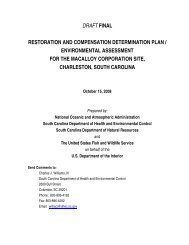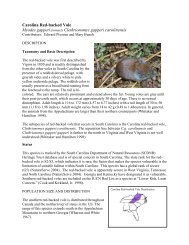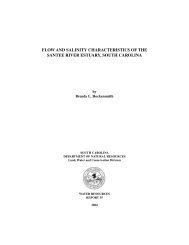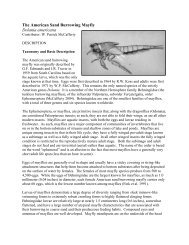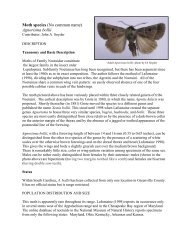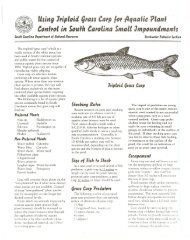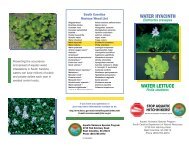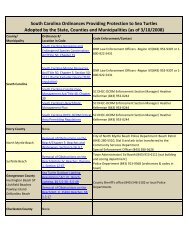Blackwater River Interactive Poster - South Carolina Department of ...
Blackwater River Interactive Poster - South Carolina Department of ...
Blackwater River Interactive Poster - South Carolina Department of ...
You also want an ePaper? Increase the reach of your titles
YUMPU automatically turns print PDFs into web optimized ePapers that Google loves.
An interactive guide to the<br />
blackwater river ecosystem
Click here for Introduction to the<br />
<strong>Blackwater</strong> <strong>River</strong> Ecosystem<br />
Click here to go directly to the<br />
<strong>Interactive</strong> poster
Dark and meandering through wooded corridors draped in Spanish moss, the blackwater<br />
rivers <strong>of</strong> <strong>South</strong> <strong>Carolina</strong> drain the coastal plain. A great diversity <strong>of</strong> plant and animal life<br />
may be found along these rivers with their sandy bottoms and forested floodplains. The<br />
blackwater rivers originate from springs in the Sandhills region <strong>of</strong> the state and flow on a<br />
windy course creating oxbows, sloughs, riffles, and pools before emptying into the<br />
Atlantic Ocean. <strong>Blackwater</strong> river levels fluctuate continuously as they are not impacted<br />
by impoundments that regulate discharge.<br />
<strong>Blackwater</strong> rivers are black due to the<br />
tannic acid leached from fallen leaves <strong>of</strong><br />
trees such as oaks that inhabit the wide<br />
floodplains along the river’s edge. As the<br />
water rises and falls, it draws nutrients<br />
from decaying plant and animal matter,<br />
known as detritus. Detritus provides the<br />
fuel for the aquatic ecosystems in these<br />
rivers. Low‐lying branches from plants<br />
and fallen snags decorate the rivers<br />
providing habitat for aquatic<br />
invertebrates and fish that become an<br />
important component <strong>of</strong> the food chain.<br />
Introduction Continued
<strong>Blackwater</strong> rivers in <strong>South</strong> <strong>Carolina</strong> such as the Edisto, Combahee and Ashepoo are<br />
mostly named for the Indian tribes that once depended upon these rivers for food and<br />
travel. Early colonists also used these rivers to transport goods from the uplands to the<br />
coasts.<br />
<strong>South</strong> <strong>Carolina</strong>’s blackwater rivers provide important habitat for a variety <strong>of</strong> species <strong>of</strong><br />
plants, fish and animals. Migratory, neo‐tropical songbirds depend upon the wooded<br />
floodplains for food, cover and nesting. Visitors to the river may sneak a peek at wood<br />
ducks, barred owls and prothonotary warblers. Anadromous fish such as striped bass<br />
and American eels utilize the rivers to migrate from the ocean to freshwater to spawn or<br />
produce eggs. Alligators, yellow‐bellied sliders, river otters and raccoons all make great<br />
use <strong>of</strong> the blackwater rivers, as well as the neighboring riparian wetlands for food,<br />
nesting and cover.
Despite the use <strong>of</strong> these rivers by many species, they are forever in peril as a result <strong>of</strong><br />
urbanization or poor land‐uses practices in the watersheds and damage to the<br />
floodplain forests. Polluted run<strong>of</strong>f containing pesticides, fertilizers, and other manmade<br />
chemicals can foul the water and harm the many organisms that use these river<br />
systems. Increased sedimentation from erosion along poorly managed riverbanks or<br />
as a result <strong>of</strong> mismanaged forest stands or farmlands also cause an increased danger to<br />
the animals and plants in these rivers. Land‐use practices that protect and conserve<br />
wildlife and water resources are needed to maintain the integrity <strong>of</strong> these rivers; and<br />
one essential practice is to keep all stream banks, on both the river and its tributary<br />
streams, protected with forested buffers. The larger and wider forested buffers are,<br />
the better they serve to protect and conserve wildlife and water resources <strong>of</strong> our rivers.<br />
The DNR has staff, information, and programs (such as State Scenic <strong>River</strong>s) that can<br />
assist citizens to better manage priceless natural resources like our blackwater rivers.
Return to<br />
Beginning<br />
Return<br />
to poster
Oops, Please return to the poster<br />
and click on the item you want<br />
to see more information. Please<br />
look for the hand cursor, then<br />
click.
•Yellow‐bellied Slider<br />
Trachemys scripta scripta<br />
Size: Adults can be 5 to 8 inches in length.<br />
Description: Oval carapace or shell with yellow bands and a yellow underside. In young and many females,<br />
there is a very prominent field mark <strong>of</strong> yellow right behind the eye. Older individuals and males may lose<br />
some <strong>of</strong> the yellow coloration and appear dark and mottled.<br />
Habitat: Swamps, ditches, rivers, shallow streams, ponds and lakes with s<strong>of</strong>t bottoms and dense vegetation.<br />
Range: <strong>South</strong>east Virginia to northern Florida.<br />
Diet: Young sliders eat a variety <strong>of</strong> insects, mollusks and tadpoles. As they mature into adulthood, they eat<br />
mainly aquatic plants.<br />
Behavior: Sliders are <strong>of</strong>ten seen basking in the sun stacked upon each other on logs and other debris in the<br />
river. Female turtles create a nest from June to July laying 1 to 3 clutches <strong>of</strong> 4 to 23 oval‐shaped eggs. The<br />
young hatch in 2 to 2 ½ months and many times overwinter in the nest.<br />
More Info<br />
Return<br />
to poster
•Brown Water Snake<br />
Nerodia taxispilota<br />
Size: Adults 30 to 60 inches long, females are larger than males.<br />
Description: Coloration is brown to dark brown with a series <strong>of</strong> large squarish brown blotches down the middle <strong>of</strong><br />
the back and alternating with similar blotches on the sides. Belly is yellow to brown with a decoration <strong>of</strong> dark<br />
squares. Often mistaken for the venomous cottonmouth or water moccasin due to the similarities in color and head<br />
shape, the brown water snake is not a venomous snake.<br />
Habitat: Favors clear, quiet waters <strong>of</strong> ponds, lakes, streams, rivers, marshes and swamps. Particularly likes areas with<br />
overhanging vegetation.<br />
Range: <strong>South</strong>eastern Virginia to tip <strong>of</strong> Florida and parts <strong>of</strong> coastal Alabama.<br />
Diet: Consists <strong>of</strong> frogs, fish, crayfish and salamanders.<br />
Behavior: Primarily diurnal or active during the day, the brown water snake is a strong swimmer, diver and climber.<br />
They are <strong>of</strong>ten seen basking in the sun on branches as high as 20 feet or more. They can also be found on low‐lying<br />
branches near the water’s edge as well as fallen trees and other debris in the river. These snakes are very easily<br />
frightened and will drop from their basking spots in an instant to avoid predators or man. Be wary, they do not<br />
hesitate to strike when cornered or stressed. Females give birth to 14 to 15 live young during June to October that<br />
are about 7 to 11 inches long.<br />
Return<br />
to poster
•American Alligator<br />
Alligator mississippiensis<br />
Size: Adults range from 6 to 16 feet in length. They are the largest reptile in North America.<br />
Description: Semi‐aquatic reptile that is generally black in color with yellow or cream‐colored bands that fade with age.<br />
They have large, course scales and prominent eyes and nostrils atop a broad, rounded snout.<br />
Habitat: <strong>River</strong>s, ponds, lakes, swamps, bayous and fresh and brackish marshes.<br />
Range: <strong>South</strong>ern and southeastern United States minus the western part <strong>of</strong> Texas.<br />
Diet: Fish, small mammals, birds, snakes, turtles, raccoons, muskrats and even other alligators.<br />
Behavior: During drought, gators dig deep holes known as gator holes that provide a source <strong>of</strong> water for other aquatic or<br />
semi‐aquatic species. Female alligators construct nests <strong>of</strong> vegetation that can be 4 to 7 feet in width and 1 ½ to 3 feet<br />
high to avoid flooding <strong>of</strong> the eggs which is fatal to the young. On average 30‐50 three‐inch long eggs are laid in the<br />
middle <strong>of</strong> the nest and incubated by the heat generated by the decaying vegetation. The temperature <strong>of</strong> the nest<br />
determines the sex <strong>of</strong> the developing embryos. The alligators will hatch out in about 9 weeks at a length <strong>of</strong> nine inches.<br />
Female alligators will defend their young for about 9 months and the young will stay near the nest in groups called pods<br />
for up to 2 to 3 years.<br />
Return<br />
to poster
•Blackbanded Darter<br />
Percina nigr<strong>of</strong>asciata<br />
Size: Adults can be up to 4 ½ inches in length.<br />
Description: Olive to dusky black in color with about 6 to 8 dark colored bands or bars along the side. Fins are clear or<br />
have a very faint dark band.<br />
Habitat: Riffles <strong>of</strong> creeks and small rivers usually over gravel or sand with vegetation or detritus.<br />
Range: Coastal plain drainages from <strong>South</strong> <strong>Carolina</strong> to eastern Louisiana and into Florida at Lake Okeechobee.<br />
Diet: Aquatic insects.<br />
Behavior: May to June is spawning season. The number <strong>of</strong> eggs a female produces is directly related to her length and<br />
weight.<br />
Return<br />
to poster
•Spotted Sucker<br />
Minytrema melanops<br />
Size: Adults grow up to 20 inches in length.<br />
Description: Dark spots on the base <strong>of</strong> each scale form parallel lines on the suckers’ sides and back. Its body color is<br />
silvery with a dark olive back. The lips are thin and striated with a U‐shaped lower lip. There is a black edge on the<br />
lower caudal fin lobe. The breeding male has 3 colors <strong>of</strong> stripes along its side: lavender, pink and brown to black.<br />
Habitat: Inhabits deep, clear pools <strong>of</strong> stream and rivers. Also can be found in lakes, reservoirs and overflow ponds.<br />
They are intolerant <strong>of</strong> turbid waters and increased sedimentation.<br />
Range: Mississippi <strong>River</strong> drainage from Minnesota south to Louisiana and coastal drainages <strong>of</strong> North <strong>Carolina</strong> south<br />
to Gulf drainages.<br />
Diet: Aquatic insects and invertebrates.<br />
Behavior: Spawning occurs in shallow riffles from mid‐March to early May. Males actively defend breeding<br />
territories over coarse rubble in riffles under 0.5 m in depth with moderate current.<br />
Return<br />
to poster
•Pumpkinseed<br />
Lepomis gibbosus<br />
Size: Adults grow up to 16 inches in length, though most only reach 4 to 6 inches.<br />
Description: Small mouth, long pointed pectoral fin with a bright red or orange spot located on the back edge <strong>of</strong> the<br />
black ear flap. The second dorsal, caudal and anal fins are covered with bold dark, brown wavy lines or orange spots.<br />
There are wav, blue lines on the cheek. The sides <strong>of</strong> the juveniles and adult females are covered in a dusky chainlike<br />
bar pattern. The male is an olive‐green color with blue and orange spots and streaked with gold along its side.<br />
Habitat: Likes cover close to shore, vegetated lakes and ponds. Also found in vegetated pools <strong>of</strong> creek and small<br />
rivers.<br />
Range: From Minnesota to northeastern United States south to <strong>South</strong> <strong>Carolina</strong>.<br />
Diet: Crustaceans, salamanders, snails, small fish and all types <strong>of</strong> insects.<br />
Behavior: Pumpkinseed spawn during the spring and summer when the water temperatures reach the mid‐60<br />
degree F range. Males build the nests near the shore, separately or in small groups, and the females’ eggs hatch<br />
within 3 days. The male guards the young for around a week and when the young leave the area, the male will clear<br />
the nest area to prepare for another spawning.<br />
Return<br />
to poster
•Bluegill<br />
Lepomis macrochirus<br />
Size: Adults grow up to 16 inches in length.<br />
Description: Bluegill have a large, black spot at the rear <strong>of</strong> the dorsal fin and <strong>of</strong>ten a dusky spot at the rear <strong>of</strong> the<br />
anal fin. If the water is not turbid, dark bars are present on the body, which is extremely compressed. The pectoral<br />
fin is long and pointed, the earflap is black up to the edge and it has a small mouth. Their color is olive‐black with<br />
yellow and green flecks and adults have a blue sheen over their bodies. On the adult breeding male, the back and<br />
head is blue, the belly is red‐orange and the pelvic fins are black.<br />
Habitat: Small to large rivers, pools <strong>of</strong> creeks, vegetated lakes, ponds and swamps.<br />
Range: From southeastern Canada to northern Mexico and east to the southeastern United States to the coast.<br />
Diet: Aquatic insects, fish eggs, minnows, worms and other small organisms.<br />
Behavior: Bluegill are active mostly during dusk and dawn and stay in deeper water during the day. April through<br />
September are the spawning months when males will build nests in shallow waters forming colonies <strong>of</strong> up to 500.<br />
The female lays anywhere from 2,000 to 63,000 eggs. Males guard the eggs and protect the young after they are<br />
hatched. Bluegill will sometimes travel in small schools.<br />
Return<br />
to poster
•Redbreast Sunfish<br />
Lepomis auritus<br />
Size: Growth up to 9 ½ inches.<br />
Description: Redbreast have several light blue streaks radiating from the mouth toward the gill cover or operculum.<br />
They have a more elongate body shape than other sunfishes. Redbreast have an olive coloration on the top <strong>of</strong> their<br />
bodies which fades to a blue‐bronze coloring on their bellies. The pectoral fins are short and round. In males, the<br />
operculum is long, narrow and completely black in color. During spawning, males also have a bright orange red belly.<br />
The female’s underside is a pale orange in comparison to the males.<br />
Habitat: The edge <strong>of</strong> vegetated and rocky lakes. Also, reside in sandy and rocky pools <strong>of</strong> creeks and small to medium<br />
rivers.<br />
Range: Throughout most <strong>of</strong> the United States, but mainly from the central United States to the Atlantic coast and up<br />
to New Brunswick, Canada.<br />
Diet: Primarily aquatic insects, but will also consume snails, crayfish, small fish and organic matter.<br />
Behavior: At the age <strong>of</strong> 2 to 3 years old, redbreast sunfish begin spawning in the spring or summer when the water<br />
temperatures reach 68 to 82 degrees F. Males build nests in protected areas over sand or gravel bottoms, unless they<br />
can find a suitable nest abandoned by other sunfish. Females can lay up to 10,000s <strong>of</strong> eggs. The amount <strong>of</strong> eggs laid<br />
varies with age and size <strong>of</strong> the females.<br />
Return<br />
to poster
•Largemouth Bass Micropterus samoides<br />
Size: Grow up to 38 inches, average size 1 to 1 ½ pounds.<br />
Description: Largemouth bass have an elongate and robust body shape. Coloration varies from a light green to a light<br />
brown hue on the back and sides. The belly is white and there is a prominent broad stripe <strong>of</strong> diamond‐shaped<br />
blotches along the middle <strong>of</strong> the body. Obviously, the largemouth bass has a distinctively large mouth, where the jaw<br />
extends past the eye.<br />
Habitat: Weedy areas <strong>of</strong> ponds, lakes, swamps, backwaters and small to large rivers that have mud or sandy bottoms.<br />
Range: Most <strong>of</strong> the United States and southern‐most areas <strong>of</strong> Ontario and Quebec.<br />
Diet: Primarily small fish such as shad and sunfishes, but also consume snakes, frogs, salamanders and mice.<br />
Behavior: Largemouth bass spawn in late winter to late spring. Males select a nest site, build the nest and nudge the<br />
female towards the nest. They will also guard the nest during incubation as well as protect the young several days<br />
after hatching. Bass do not leave their territory unless there is an environmental pressure to do so.<br />
Return<br />
to poster
•Striped Bass<br />
Morone saxitilis<br />
Size: Growth up to 79 inches.<br />
Description: Striped bass are large fish with a streamlined body and head with a protruding lower jaw, forked tail and<br />
small eyes. They are bluish‐black or dark green on their backs with a white belly. They have 6 to 9 prominent dark<br />
gray stripes along their silvery sides. Fins are dusky silver except the white pectoral fins. Breeding adults and young<br />
less than 4 inches in length have 8 to 10 vertical bars that are dark but disappear as the fish matures.<br />
Habitat: Freshwater rivers and estuaries around piles, piers and snags. Where impoundments aren’t present, adults<br />
migrate upriver in the summer to cooler waters and then migrate back down in the winter to estuarine habitats.<br />
Range: Along the Atlantic coast, the Gulf <strong>of</strong> Mexico, East Coast inland river systems and the along the Pacific coast.<br />
Diet: Small fish such as flounder and eels, but will also consume worms, crabs, zooplankton, freshwater shrimp,<br />
midge larvae, shad, minnows, amphipods and mayflies.<br />
Behavior: By age 2 or 3, male striped bass are ready to spawn. Females reach spawning age at 8 or 9 years <strong>of</strong> age.<br />
They feed while migrating to their spawning grounds and stop abruptly before they spawn. Spawning occurs from<br />
late winter to early spring. The preferred spawning areas are mainstream areas where current or tidal action is strong<br />
enough to keep the eggs suspended. Each female can lie anywhere from 180,000 to 4.5 million eggs. After the eggs<br />
are laid, young will hatch two to three days later and move downstream to the estuarine area <strong>of</strong> the rivers in late<br />
summer and early fall.<br />
Return<br />
to poster
•American Eel<br />
Anguilla rostrata<br />
Size: Grow up to 60 inches.<br />
Description: The American Eel is a snake‐shaped fish, however, they are not a snake. Snakes are reptiles that breathe<br />
in oxygen with lungs, whereas eels are fish that breathe using gills and also have fins. Eels have a dark olive,<br />
yellowish or slate‐gray color on the top part <strong>of</strong> their body and a lighter color below.<br />
Habitat: Permanent streams with a constant flow.<br />
Range: Atlantic Ocean to Great Lakes, Mississippi <strong>River</strong> drainage and Gulf <strong>of</strong> Mexico basin; found along Atlantic Coast<br />
from northeastern Canada to <strong>South</strong> America.<br />
Diet: Small fish, crayfish, crabs, insects and worms.<br />
Behavior: The American eel is catadramous, which means it spawns or lays its eggs in the ocean or saltwater and<br />
then lives the rest <strong>of</strong> its life in freshwater. American eels migrate from freshwater to the Sargasso Sea in the Atlantic<br />
Ocean (between Bermuda and the West Indies) to spawn. After spawning, the adult eels die. The eel eggs hatch into<br />
a larva form called a leptocephalus. The leptocephalus are carried by currents back to the shores <strong>of</strong> North America.<br />
Once back near shore, the larva will transform into a very small, transparent adult‐look alike known as a “glass‐eel.”<br />
The glass‐eels will develop a darker coloration (pigment) and then will be known as an elver. The elvers then grow<br />
through the yellow and black eel phases until they become a full adult. Male eels will live in brackish water along the<br />
coastal areas whereas females will migrate as far upstream as they can where they will remain for as long as 15 years.<br />
Return<br />
to poster
•Bowfin<br />
Amia calva<br />
Size: Grows up to 43 inches long, averaging 2 to 5 pounds.<br />
Description: Bowfin have a large flattened head, a long spineless dorsal fin that extends almost the entire length <strong>of</strong><br />
its body, tube‐like nostrils and long, sharp teeth. They have large olive‐colored scales which give bowfin a brown or<br />
gray coloration on their backs and sides which fades into a white or cream on the underside. There is a very<br />
distinctive dark spot on the upper portion <strong>of</strong> a male bowfin’s tail with a yellow‐orange rim. On the females, there is a<br />
lighter spot, but no rim.<br />
Habitat: Backwaters or lowland streams, pools, weedy rivers and sloughs.<br />
Range: From the St. Lawrence <strong>River</strong> and Lake Champlain drainages in North America to the Mississippi <strong>River</strong><br />
drainage.<br />
Diet: Variety <strong>of</strong> crayfish, larvae, shrimp, adult insects, frogs, small fish and large amounts <strong>of</strong> vegetation.<br />
Behavior: Bowfin are most active in the evening. They have a lung‐like air bladder that allows them to breathe<br />
surface air in addition to their gills. This adaptation allows them to live in stagnant water where other fish are unable<br />
to live. Spawning occurs between April and June when bowfin reach 3 to 5 years <strong>of</strong> age. Males build the nest, stay<br />
with the eggs and protect the young after they hatch for 8 to 10 days. Young bowfin have a sticky organ on their<br />
noses that allows them to attach to the bottom <strong>of</strong> nests until they grow about ½ inch long. Bowfin are commonly<br />
referred to as “mudfish.”<br />
Return<br />
to poster
•Blue Catfish<br />
Ictalurus furcatus<br />
Size: Grow up to 65 inches, averaging 5 to 20 pounds.<br />
Description: Blue catfish range in color from a blue‐gray to a slate‐blue, some are almost pale blue or silvery. The<br />
colors fade from dark to light from the back to the belly <strong>of</strong> the fish. There are no dark spots on the body except for<br />
the blue catfish in the Rio Grande. Just like other catfish, the blue catfish has no scales. Their tails are deeply forked<br />
with fins that are clear to white. The dorsal and caudal fins are also clear or white, but they have a black to dusky<br />
border along the fin’s edge. The barbels, sensory organs located around the face <strong>of</strong> the catfish, are white.<br />
Habitat: Areas with strong currents over rock, gravel or sand bottoms. Prefer big rivers, lakes and reservoirs, but may<br />
also be found in ponds, streams and other variable sized rivers.<br />
Range: Central and eastern United States.<br />
Diet: Fish, crayfish, aquatic insects and clams. They are opportunistic feeders, meaning they will eat almost anything<br />
they can catch. They forage at night along the bottom.<br />
Behavior: Spawning occurs in spring or early summer as water temperatures reach 70 to 75 degrees F. Either the<br />
male, female or both catfish will construct the nest in a secluded, dark place.<br />
Return<br />
to poster
•Flathead Catfish<br />
Pylodictis olivaris<br />
Size: Growth up to 61 inches, average weight is several pounds to 10‐15 pounds.<br />
Description: Flathead catfish have flat and wide heads with small eyes placed slightly towards the top <strong>of</strong> the head.<br />
They have long mouth barbels and heavy, sharp pectoral and dorsal spines. They vary in color with mottled shades <strong>of</strong><br />
yellow and brown which fades to a light whitish belly. The tail is rounded instead <strong>of</strong> forked and the anal fin is short<br />
and rounded in comparison to other catfish species.<br />
Habitat: Primarily large bodies <strong>of</strong> water, but also found in rivers and small lakes and impoundments. They prefer<br />
slow‐moving water with a hard bottom with depressions or holes and debris such as timber and driftwood.<br />
Range: Lower Great Lakes to the Mississippi <strong>River</strong> basins, south to northern Mexico and east to the Florida<br />
panhandle.<br />
Diet: Fish, crayfish, insects and clams. They are opportunistic feeders.<br />
Behavior: Flatheads are most active at night. During spring or early summer, they spawn with one <strong>of</strong> both parents<br />
constructing the nest in undercut banks around crevices and holes under logs and trees. Males guard and aerate the<br />
eggs and guard the young after hatching until they disperse.<br />
Return<br />
to poster
•Prothonotary Warbler<br />
Protonotaria citrea<br />
Size: Adults are 5 ½ inches in length.<br />
Description: Males are a bright yellow on head and underparts with blue‐gray wings and tail. Without wing bars, but<br />
tail has large white patches on each side. Eyes are large and dark. The females are similar but slightly duller in color.<br />
Habitat: Wooded swamps, backwaters, flooded bottomland forests and river edges.<br />
Range: Breeds throughout southeastern United States, winters in tropics, primarily central America.<br />
Diet: Mainly insects and other small invertebrates.<br />
Behavior: The prothonotary warbler, unlike other warblers, is a secondary cavity nester—nesting in existing holes in<br />
trees, stumps or stubs. Its nests are almost always near standing water and found commonly about five feet <strong>of</strong>f the<br />
ground. This bird will also use man‐made structures such as nest boxes and other less natural places like glass jars<br />
and mailboxes.<br />
Return<br />
to poster
•Wood Duck<br />
Aix sponsa<br />
Size: Adults 17 to 20 inches long.<br />
Description: Males and females are sexually dimorphic or different in coloration. Males are dark above with a rich<br />
chestnut chest, flecked with little white pyramids and patterned with iridescent greens, purples and blues. Males<br />
have a prominent white outline around their eyes. Females are much duller and have more <strong>of</strong> a gray coloration with<br />
a broader white eye‐ring.<br />
Habitat: Wooded swamps, rivers and ponds. Winters on both freshwater and brackish marshes, ponds, streams and<br />
estuaries.<br />
Range: Throughout eastern United States.<br />
Diet: Consists <strong>of</strong> about 90% plant matter including seeds, fruits, nuts, plants and grasses. Adults will also consume<br />
plants, seeds, acorns, aquatic animals and invertebrates and insects which are the main component <strong>of</strong> a juvenile’s<br />
diet.<br />
Behavior: Wood ducks nest in cavities <strong>of</strong> trees in wooded swamps and in freshwater sloughs. Man‐made nest boxes<br />
have greatly increased the breeding success <strong>of</strong> this species in areas where suitable nesting trees are no longer<br />
present. Nesting peaks from March through April. Twelve or more eggs are laid with an incubation period <strong>of</strong> 27 to<br />
30 days. When ready to leave the nest, the young will jump from the nest to the ground or water.<br />
Return<br />
to poster
•Great Egret<br />
Ardea alba<br />
Size: Adults are 35 to 41 inches long.<br />
Description: Large wading bird with all white plumage with a yellow bill and black legs and feet. In breeding<br />
plumage, long white plumes extend from the back beyond the end <strong>of</strong> the tail.<br />
Habitat: Ponds, freshwater and saltwater marshes and tidal flats.<br />
Range: Breeds from the south north to Oregon and New Jersey, winters south to <strong>South</strong> America.<br />
Diet: Primarily fish and frogs, but will also eat insects, crayfish, snakes, small mammals and occasionally birds. Forage<br />
in shallow water by stalking prey.<br />
Behavior: Great egrets nest alone or in colonies with other colonial water birds, near water, <strong>of</strong>ten 20 to 40 feet up in<br />
trees. They build platform like nests from sticks in late April or early May. The 3 greenish‐blue eggs take about 23 to<br />
24 days to hatch.<br />
Return<br />
to poster
•Great Blue Heron<br />
Ardea herodias<br />
Size: Adults are 42 to 50 inches in length.<br />
Description: Large blue gray wading bird that stands about 4 feet tall with a white head with a black cap, long legs<br />
and neck and a sharply pointed beak. Feet are not webbed. Flies with its head in an S‐shaped position, versus<br />
straight out like a cranes, storks or ibises, with its legs trailing behind.<br />
Habitat: <strong>River</strong>s, freshwater and brackish marshes, ponds, lakes and fields<br />
Range: Breeds throughout North America and winters as far north as the Great Lakes.<br />
Diet: Primarily fish, but will also eat insects, crayfish, snakes, small mammals, frogs and occasionally birds.<br />
Behavior: Great blue herons hunt by standing motionless in shallow water waiting to spear passing prey with their<br />
sharp bill. They nest in loose colonies, <strong>of</strong>ten in tops <strong>of</strong> tall trees, sometimes with other wading bird species. Nests<br />
are large, built in tress 30 to 70 feet from the ground. The 3 to 5 pale bluish‐green eggs hatch in 28 days. The<br />
juvenile birds take flight in 55 to 60 days.<br />
Return<br />
to poster
•Wood Stork<br />
Mycteria americana<br />
Size: Adults are 34 to 47 inches, wingspread is 5 ½ feet.<br />
Description: Large bird with white body except for black on the underside <strong>of</strong> the wings and tail. The head and neck is<br />
bare and gray in color. Bill is long, thick and slightly curved. In adults, the bill is black and in subadults, yellow.<br />
Habitat: Coastal ponds and marshes, nesting occurs in cypress swamps, but feeds in shallow freshwater areas inland.<br />
Range: Coastal <strong>South</strong> <strong>Carolina</strong> to coastal Louisiana to Argentina.<br />
Diet: Consists primarily <strong>of</strong> fish, but also includes insects, crustaceans, frogs, lizards and even small mammals such as<br />
rodents.<br />
Behavior: Wood storks are the only stork that breeds in North America. Nesting storks can be found alone or in large<br />
groups or colonies in trees and bushes with other wading birds such as herons and ibises. Colonies can include as<br />
many as 10,000 pairs! With such a large wingspread <strong>of</strong> 5 ½ feet, wood storks can be seen <strong>of</strong>ten circling or soaring as<br />
they rise in thermal air currents. The wood stork is currently listed as an endangered species.<br />
Return<br />
to poster
•Swallow‐tailed Kite<br />
Elanoides forficatus<br />
Size: Adults are 22 to 24 inches.<br />
Description: Small diurnal raptor with similar in coloration to a gull, but much more graceful in flight. They have long,<br />
pointed wings and a deeply forked tail. The head, belly and a portion <strong>of</strong> the wings are white. The kite’s back, tops <strong>of</strong><br />
wings and tails and a portion <strong>of</strong> the underside <strong>of</strong> the wings are black.<br />
Habitat: Marshes, swamps and wooded river bottoms with scattered pine trees. Forages over open agricultural<br />
fields.<br />
Range: Summers are spent in coastal southeastern United States from the <strong>Carolina</strong>s to Mississippi, winters are spent<br />
in <strong>South</strong> America.<br />
Diet: Consists <strong>of</strong> insects, small lizards and snakes. Feeds mostly while in flight.<br />
Behavior: Obtains most <strong>of</strong> its food, water and nesting material while flying. Nest consists <strong>of</strong> mostly twigs, lined with<br />
Spanish moss in tall trees. The eggs are a creamy‐white and boldly marked with brown. Two to four eggs are laid<br />
during the nesting season. Gregarious found nesting in neighborhoods sometimes in the same locations year after<br />
year and foraging in large groups.<br />
Return<br />
to poster
•Barred OwlStrix varia<br />
Size: Adults are 17 to 24 inches in length.<br />
Description: A large gray‐brown owl with a barred pattern in brown and white across the chest. There are also white<br />
specks amongst the brown coloration on the back <strong>of</strong> the owl. Most owls’ eyes are noticeable due to their size, but<br />
barred owls have very prominent deep brown eyes.<br />
Habitat: Wooded river bottoms and swamps.<br />
Range: Central United States and Canada to the East Coast, also found from northern California to British Columbia.<br />
Diet: Primarily small mammals, but also other mammals, birds, reptiles, amphibians and invertebrates.<br />
Behavior: The barred owl <strong>of</strong>ten rests quietly during the day in lowland forests amongst thick groves <strong>of</strong> trees. This<br />
owl frequently calls during the daytime, but comes out to feed mainly at night. Barred owls nest in tree cavities, old<br />
crow’s nests and sometimes abandoned buildings. Nesting season begins in January and goes until March.<br />
Return<br />
to poster
•Virginia Opossum<br />
Didelphis virginiana<br />
Size: Adults are 25 to 40 inches long and weigh 4 to 14 pounds. Males are usually larger than other males.<br />
Description: Similar in size to a housecat, except for a heavier body with shorter legs. Head<br />
is narrow and tapered down to a pointed muzzle. Ears are large with no hair, black and pinkish tips. Fur color<br />
appears gray or black. Tail has no fur and is prehensile. Head and throat appear whitish. The female has a fur‐lined<br />
abdominal pouch where she carries her young. The Virginia opossum is the only marsupial native to the United<br />
States.<br />
Habitat: Deciduous forests, farmlands, open woods, brushy wastelands and urban areas.<br />
Range: Most <strong>of</strong> eastern and central regions <strong>of</strong> North America and a segment down the Pacific Coast.<br />
Diet: Consists mostly <strong>of</strong> carrion, many times feeding on road kill. Also includes insects, frogs, birds, snakes, crayfish,<br />
earthworms, small mammals and berries. Other fruits include persimmons, apples and corn.<br />
Behavior: The opossum is solitary, nocturnal, terrestrial, arboreal and climbs well. After a 12‐13 day gestation,<br />
female opossums will give birth to 1 to 14 young that are about the size <strong>of</strong> a dime. Each tiny <strong>of</strong>fspring will climb to<br />
the mother’s pouch where they attach to a nipple for two months. Opossums are <strong>of</strong>ten seen using defensive<br />
behaviors to protect themselves from predators such as playing dead or “possum,” hissing, screeching, salivating and<br />
opening its mouth wide to exhibit its 50 teeth.<br />
Return<br />
to poster
•Raccoon<br />
Procyon lotor<br />
Size: Adults are 24 to 37 inches long and weigh 12 to 48 pounds.<br />
Description: Usually gray to brownish‐red in color with a wide black face mask and black rings on the tail.<br />
Habitat: Variety <strong>of</strong> habitats including cities, suburbs and rural areas. Most commonly found throughout wooded and<br />
wetland habitats, particularly coastal marshes and bottomland hardwoods.<br />
Range: Throughout most <strong>of</strong> United States and southern Canada.<br />
Diet: Consists <strong>of</strong> grapes, nuts, berries, pawpaw, black cherry, insects, small mammals, bird eggs, nestlings, frogs,<br />
crayfish, worms fish, turtles and mussels.<br />
Behavior: Raccoons are solitary, nocturnal, agile tree climbers and strong swimmers. They have very nimble fingers<br />
and can easily turn a doorknob, open a refrigerator or open a trash can in a residential area. If water is nearby,<br />
raccoons will sometimes wash their food to sort out the inedible parts. During the winter, raccoons will sometimes<br />
sleep in a den for several days or months at a time without food. Their bodies store a third <strong>of</strong> its weight as fat which<br />
helps sustain them through the winter. (Note: Raccoons do not hibernate.) Females will give birth to 1 to 8 young in<br />
the spring after a gestation <strong>of</strong> 63 days.<br />
Return<br />
to poster
•Northern <strong>River</strong> Otter<br />
Lontra canadensis<br />
Size: Adults are 35 to 52 inches long and weigh 11 to 30 pounds. Males are larger than females.<br />
Description: Dark brown, aquatic mammal with a long, streamlined body with a broad, flattened head, somewhat<br />
seal‐like. The belly <strong>of</strong> the animal is a lighter color and there is also a silver gray throat patch. They have very<br />
prominent, whitish whiskers as well as a long, thick rudder‐like tail. Being an aquatic mammal, it is advantageous that<br />
these otters have webbed feet as well as ears and nostrils that are valved to keep out water.<br />
Habitat: Primarily along rivers, ponds and lakes in wooded areas, but will roam far from water.<br />
Range: Distributed across most <strong>of</strong> Canada and found in the northwest, northeast and southeast <strong>of</strong> the United States.<br />
Diet: Consists <strong>of</strong> primarily fish, but they will eat small mammals and invertebrates.<br />
Behavior: The river otter is active during the day unless their environment is disturbed by human activity. They swim<br />
rapidly in water and submerge in water as deep as 55 feet. They also walk, slide and run fairly well on land. <strong>River</strong><br />
otters are very playful and will enjoy sliding and frolicking in water alone or in family groups. Females can give birth<br />
to 1 to 6 pups (most common 2 to 3 pups) in the spring after an 8 to 9 ½ month gestation.<br />
Return<br />
to poster
•White‐tailed Deer<br />
Odocoileus virginianus<br />
Size: Males can weigh 150‐310 pounds and females can weigh 90‐211 pounds, size varies greatly by region and<br />
depends upon food availability.<br />
Description: Reddish‐brown or tan body during the summer and spring and a more gray body in the winter. Very<br />
distinct white coloration on the underside <strong>of</strong> the tail, belly, throat and above the nose.<br />
Habitat: Brushy areas, farmlands, woods, suburbs and gardens.<br />
Range: <strong>South</strong>ern portion <strong>of</strong> Canada, most <strong>of</strong> United States, except for the extreme <strong>South</strong>west, Central America and<br />
the northern part <strong>of</strong> <strong>South</strong> America.<br />
Diet: Consists <strong>of</strong> acorns, leaves, twigs, fruit and buds <strong>of</strong> trees and shrubs.<br />
Behavior: Deer are crepuscular which means they are active early in the day right before sunrise and late in the<br />
evening just after sunset. During the day, deer rest or sleep in thick cover. They feed along trails and open fields.<br />
Deer are great athletes! They can run at speeds <strong>of</strong> 36 mph and make vertical leaps <strong>of</strong> 8 ½ feet and horizontal leaps <strong>of</strong><br />
30 feet. They are also great swimmers. The breeding season or rut begins in early fall and continues through early<br />
winter. Females typically give birth to a single fawn with their first pregnancy and twins are the rule for adults after a<br />
6 ½ month gestation period. Does will leave their fawns unattended while feeding, returning to the fawn several time<br />
to nurse. Bucks will develop antlers beginning in early summer and lose them in winter after the rut.<br />
Return<br />
to poster
•Yellow‐bellied Slider<br />
Trachemys scripta scripta<br />
Range <strong>of</strong> the<br />
Yellow‐Bellied Slider<br />
Return<br />
to poster



